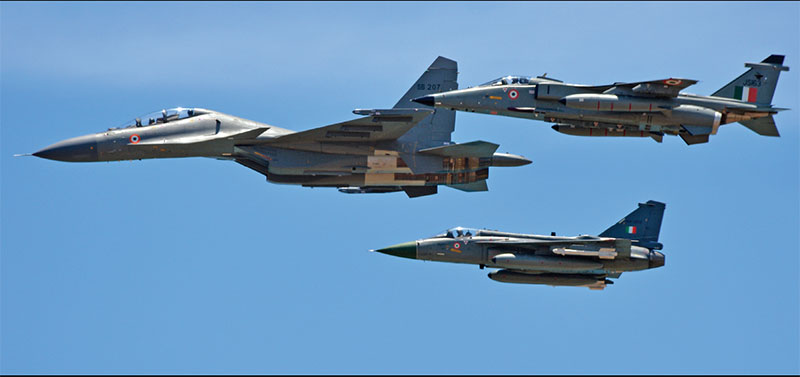The IAF will add nine more squadrons by 2025-26 to make up its depleted strength
Atul Kumar
To boost its depleting fighter strength, the Indian Air Force (IAF) is planning to add nine squadrons by 2025-26, comprising 36 Rafales, 21 MiG-29s, 18 Su-30MKIs, 24 LCA Mk.1 and 83 LCA Mk.1A. The Ambala-based ‘Golden Arrows’ squadron has been resuscitated to induct the first four Rafale fighters scheduled to arrive in India in October.

Dassault Aviation’s Rafale integrates a robust and reliable suite of sensors comprising RBE-2-AA AESA radar, long-range FSO (front sector optronics) optoelectronics IR system, internal Spectra EW suite and 3rd-Gen Damocles targeting pod (can be replaced by new TALIOS) as well as AREOS recce pod. The entire sensor suite has been developed by Thales in collaboration with MBDA and Safran Defence and Electronics. The Indian Rafales will feature some 13 India-specific enhancements. There is speculation that contract for 36 more off-the-shelf Rafales could be signed by the next year taking the total numbers to 72.
The IAF is also in the process of adding an additional squadron (18 aircraft) of Su-30MKI, the order for which is likely to be concluded by 2022. “We have fully met our commitments on delivering all technological sets of Su-30MKI fighter jets and have received an additional bid for another 18 technological sets. The bid is being worked out,” deputy director of Russia’s FSMTC, Vladimir Drozhzhov was quoted as saying by the TASS news agency.
As of now, a total of 272 aircraft have been ordered, out of which 50 were directly imported and later upgraded to MKIs at Hindustan Aeronautics Ltd (HAL), while the rest are being manufactured at HAL under Transfer of Technology. Currently, over 250 Su-30MKIs are in active service with the IAF and rest being manufactured at HAL’s Nasik division and will be delivered by March 2020.
Su-30MKI was tailored especially for the IAF by HAL jointly with Sukhoi, the aircraft features exceptionally customised avionics and systems suite such as digital multi-mode N011M Bars hybrid PESA radar and OLS-30 LR/IRST system from Russia, Elbit Su 967 Head-Up display and EL/M-8222 EW Jammer pod as well as lightning targeting pod from Israel, primary cockpit instrumentation and Sigma-95 GPS from France and Indian Tarang RWR and MFDs. Moreover, Indian variant accommodates twin canards with NPO Saturn AL-31FP turbofan thrust-vectoring engine to attain superior manoeuvres like Pugachev’s Cobra and high angle of attack. The aircraft incorporates a number of hardware and other systems similar to Su-35, which is why it is considered superior among all Su-30 variants along with Russian Air Force’s Su-30SM.
The Su-30MKI squadrons form the backbone of Indian air space protection. To further strengthen its spinal column, an upgrade called ‘Super Sukhoi’ has also been in the pipeline since 2012. The ‘Super Su-30 project’ was planned to reinforce the current capabilities of the aircraft without making any changes to the airframe and would be executed by HAL in collaboration with Defence Research and Development Organisation and Sukhoi Aviation Company.
The upgrade will integrate indigenously developed avionics including upgraded mission computers, a new-generation InfraRed Search and Track sensor, larger smart MFDs from Samtel-HAL joint venture, an EW suite with DARE’s High Band Jammer (HBJ) and digital DR-118 radar warning receiver. The upgrade also involves a new powerful engine and an AESA radar that eventually would come from Russia, Saturn AL-41F turbofan and Phazotron Zhuk-AE X-band AESA radar are currently the potent contenders for integration, these upgrades will put the aircraft into Su-35 standard as per capabilities and firepower. Furthermore, the aircraft would accommodate some advanced weapon integration under ‘Super’ upgrades including BrahMos-A, I-derby ER, ASRAAM and BrahMos NG when available.
Two successful test firings of air-launched BrahMos-A supersonic cruise missile from Su-30MKI have already taken place and by next year missile will be ready for deployment with the IAF. In the next two to three years, the IAF will equip its 40 Su-30MKIs with BrahMos ALCM. Besides this, a lighter version of the missile, called BrahMos-NG and weighing only 1.5 tonne, is also under development. This will be available in air, underwater and surface launch variants and is likely to be ready for trials in next the couple of years. With 300 km range and 3.5Mach speed, BrahMos-NG will also come with a mode to intercept slow-moving large aerial targets. Su-30MKI would able to carry five BrahMos-NG missiles.
The IAF also plans to arm Su-30MKI and Light Combat Aircraft Tejas with Rafael’s latest long-range SDR seeker equipping I-derby ER BVR and MBDA’s ASRAAM heat-seeking IR homing short-range air-to-air missiles. The FSMTC Russia has also confirmed a USD700 million contract for providing over 1,000 air-to-air missiles to replace vintage Russian air-to-air munitions by their latest improved variants. The deal possibly includes the delivery of R-27, R-73E and R-77 AAMs.
You must be logged in to view this content.

